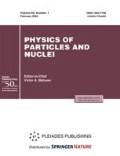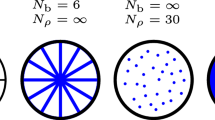Abstract
The possibility of taming the sign problem, which arises in the study of fermionic systems with finite chemical potential, with the use of algorithms of neural networks is examined. A solution to the sign problem is crucial for current research in condensed matter physics and the physics of high-density quark–gluon plasma (a new state of matter to be studied at the FAIR and NICA accelerators, which are under construction). In the proposed approach, trained neural networks roughly reproduce Lefschetz thimbles: manifolds in complex space, where the imaginary part of the action is constant. It is demonstrated that a trained network speeds up (compared to the common gradient flow algorithm) substantially the construction of the integration manifold in complex space. It is also shown that fluctuations of the imaginary part of the action on the approximate manifold defined by the neural network are still substantially smaller than in the common reweighting method.












Similar content being viewed by others
REFERENCES
Ultra-Cold Fermi Gases. Proceedings of the International School of Physics “Enrico Fermi,” 164th Course, Varenna, Italy, 2006, Ed. by M. Inguscio, W. Ketterlen, and C. Salomon (IOS Press, 2007).
T. Schäfer and D. Teaney, “Nearly perfect fluidity: From cold atomic gases to hot quark gluon plasmas,” Rep. Prog. Phys. 72, 126001 (2009); arXiv:0904.3107 [hep-ph].
L. Rammelmüller, A. C. Loheac, J. E. Drut, and J. Braun, “Finite temperature equation of state of polarized fermions at unitarity,” Phys. Rev. Lett. 121, 173001 (2018); arXiv:1807.04664 [cond-mat].
M. Troyer and U.-J. Wiese, “Computational complexity and fundamental limitations to fermionic quantum Monte Carlo simulations,” Phys. Rev. Lett. 94, 170201 (2005;, arXiv:0408370 [cond-mat].
F. Karsch, B.-J. Schaefer, M. Wagner, and J. Wambach, “Towards finite density QCD with Taylor expansions,” Phys. Lett. B 698, 256–264 (2011); arXiv: 1009.5211 [hep-ph].
A. Bazavov, H.-T. Ding, P. Hegde, O. Kaczmarek, F. Karsch, E. Laermann, Y. Maezawa, S. Mukherjee, H. Ohno, P. Petreczky, H. Sandmeyer, P. Steinbrecher, C. Schmidt, S. Sharma, W. Soeldner, and M. Wagner, “QCD equation of state to \(\mathcal{O}(\mathop \mu \nolimits_B^6 )\) from lattice QCD,” Phys. Rev. D 95, 054504 (2017); arXiv:1701.04325 [hep-lat].
V. G. Bornyakov, D. L. Boyda, V. A. Goy, A. V. Molochkov, A. Nakamura, A. A. Nikolaev, and V. I. Zakharov, “New approach to canonical partition functions computation in \({{N}_{f}} = 2\) lattice QCD at finite baryon density,” Phys. Rev. D 95, 094506 (2017); arXiv:1611.04229 [hep-lat].
G. Aarts, “Complex Langevin dynamics and other approaches at finite chemical potential,” in Proceedings of the 30th International Symposium on Lattice Field Theory, Cairns, Australia,2012, arXiv:1302.3028 [hep-lat].
G. Aarts, L. Bongiovanni, E. Seiler, D. Sexty, and I.‑O. Stamatescu, “Controlling complex Langevin dynamics at finite density,” Eur. Phys. J. A 49, 89 (2013); arXiv:1303.6425 [hep-lat].
D. Sexty, “Simulating full QCD at nonzero density using the complex Langevin equation,” Phys. Lett. B 729, 108–111 (2014); arXiv:1307.7748 [hep-lat].
K. Nagata, J. Nishimura, and S. Shimasaki, “Gauge cooling for the singular-drift problem in the complex Langevin method – a test in random matrix theory for finite density QCD,” J. High Energy Phys. 2016 (07), 73 (2016); arXiv:1604.07717 [hep-lat].
G. Aarts, E. Seiler, D. Sexty, and I.-O. Stamatescu, “Complex Langevin dynamics and zeroes of the fermion determinant,” J. High Energy Phys. 2017 (05), 44 (2017); arXiv:1701.02322 [hep-lat].
J. Bloch, J. Glesaaen, J. J. M. Verbaarschot, and S. Zafeiropoulos, “Complex Langevin simulation of a random matrix model at nonzero chemical potential,” J. High Energy Phys. 2018 (03), 15 (2018); arXiv: 1712.07514 [hep-lat].
K. N. Anagnostopoulos, T. Azuma, Y. Ito, J. Nishimura, and S. Kovalkov Papadoudis, “Complex Langevin analysis of the spontaneous symmetry breaking in dimensionally reduced super Yang–Mills models,” J. High Energy Phys. 2018 (02), 151 (2018); arXiv: 1712.07562 [hep-lat].
M. Scherzer, E. Seiler, D. Sexty, and I.-O. Stamatescu, “Complex Langevin and boundary terms,” Phys. Rev. D 99, 014512 (2019); arXiv:1808.05187 [hep-lat].
E. Witten, “A new look at the path integral of quantum mechanics,” arXiv:1009.6032 [hep-th].
E. Witten, “Analytic continuation of Chern–Simons theory,” in Chern–Simons Gauge Theory: 20 Years After, Ed. by J. E. Andersen, H. U. Boden, A. Hahn, and B. Himpel (American Mathematical Society, 2011), pp. 347–446; arXiv:1001.2933 [hep-th].
M. Cristoforetti, F. Di Renzo, and L. Scorzato, “New approach to the sign problem in quantum field theories: High density QCD on a Lefschetz thimble,” Phys. Rev. D 86, 074506 (2012); arXiv:1205.3996 [hep-lat].
M. Cristoforetti, F. Di Renzo, A. Mukherjee, and L. Scorzato, “Quantum field theories on the Lefschetz thimble,” in Proceedings of the 31st International Symposium on Lattice Field Theory, Mainz, Germany,2013, arXiv:1312.1052 [hep-lat].
M. Cristoforetti, F. Di Renzo, A. Mukherjee, and L. Scorzato, “Monte Carlo simulations on the Lefschetz thimble: Taming the sign problem,” Phys. Rev. D 88, 051501(R) (2013); arXiv:1303.7204 [hep-lat].
H. Fujii, D. Honda, M. Kato, Y. Kikukawa, S. Komatsu, and T. Sano, “Hybrid Monte Carlo on Lefschetz thimbles—A study of the residual sign problem,” J. High Energy Phys. 2013 (10), 147 (2013); arXiv: 1309.4371 [hep-lat].
H. Fujii, S. Kamata, and Y. Kikukawa, “Lefschetz thimble structure in one dimensional lattice Thirring model at finite density,” J. High Energy Phys. 2015 (11), 078 (2015); arXiv:1509.08176 [hep-lat].
Y. Tanizaki, Y. Hidaka, and T. Hayata, “Lefschetz-thimble analysis of the sign problem in one-site fermion model,” New J. Phys. 18, 033002 (2016); arXiv: 1509.07146 [hep-th].
T. Kanazawa and Y. Tanizaki, “Structure of Lefschetz thimbles in simple fermionic systems,” J. High Energy Phys. 2015 (03), 044 (2015); arXiv:1412.2802 [hep-lat].
A. Alexandru, G. Başar, and P. Bedaque, “Monte Carlo algorithm for simulating fermions on Lefschetz thimbles,” Phys. Rev. D 93, 014504 (2016); arXiv: 1510.03258 [hep-lat].
A. Alexandru, G. Basar, P. F. Bedaque, G. W. Ridgway, and N. C. Warrington, “Sign problem and Monte Carlo calculations beyond Lefschetz thimbles,” J. High Energy Phys. 2016 (05), 053 (2016); arXiv:1512.08764 [hep-lat].
A. Alexandru, P. F. Bedaque, H. Lamm, and S. Lawrence, “Deep learning beyond Lefschetz thimbles,” Phys. Rev. D 96, 094505 (2017); arXiv:1709.01971 [hep-lat].
F. Di Renzo and G. Eruzzi, “Thimble regularization at work: From toy models to chiral random matrix theories,” Phys. Rev. D 92, 085030 (2015); arXiv: 1507.03858 [hep-lat].
A. Alexandru, G. Başar, P. F. Bedaque, G. W. Ridgway, and N. C. Warrington, “Monte Carlo calculations of the finite density Thirring model,” Phys. Rev. D 95, 014502 (2017); arXiv:1609.01730 [hep-lat].
A. Alexandru, P. F. Bedaque, and N. C. Warrington, “Spin polarized nonrelativistic fermions in 1+1 dimensions,” Phys. Rev. D 98, 054514 (2018); arXiv: 1805.00125 [hep-lat].
A. Alexandru, G. Başar, P. F. Bedaque, H. Lamm, and S. Lawrence, “Finite density QED1+1 near Lefschetz thimbles,” Phys. Rev. D 98, 034506 (2018); arXiv: 1807.02027 [hep-lat].
A. Alexandru, P. F. Bedaque, H. Lamm, S. Lawrence, and N. C. Warrington, “Fermions at finite density in \(2 + 1\) dimensions with sign-optimized manifolds,” Phys. Rev. Lett. 121, 191602 (2018); arXiv:1808.09799 [hep-lat].
S. Bluecher, J. M. Pawlowski, M. Scherzer, M. Schlosser, I.-O. Stamatescu, S. Syrkowski, and F. P. G. Ziegler, “Reweighting Lefschetz thimbles,” SciPost Phys. 5, 044 (2018); arXiv:1803.08418 [hep-lat].
P. V. Buividovich and M. I. Polikarpov, “Monte Carlo study of the electron transport properties of monolayer graphene within the tight-binding model,” Phys. Rev. B 86, 245117 (2012); arXiv:1206.0619 [cond-mat.str-el].
M. V. Ulybyshev, P. V. Buividovich, M. I. Katsnelson, and M. I. Polikarpov, “Monte Carlo study of the semimetal-insulator phase transition in monolayer graphene with a realistic interelectron interaction potential,” Phys. Rev. Lett. 111, 056801 (2013); arXiv: 1304.3660 [cond-mat.str-el].
D. Smith and L. von Smekal, “Monte Carlo simulation of the tight-binding model of graphene with partially screened Coulomb interactions,” Phys. Rev. B 89, 195429 (2014), arXiv:1403.3620 [hep-lat].
P. V. Buividovich and M. V. Ulybyshev, “Applications of lattice QCD techniques for condensed matter systems,” Int. J. Mod. Phys. A 31, 1643008 (2016); arXiv: 1602.08431 [hep-lat].
M. Hohenadler, F. Parisen Toldin, I. F. Herbut, and F. F. Assaad, “Phase diagram of the Kane–Mele–Coulomb model,” Phys. Rev. B 90, 085146 (2014); arXiv: 1407.2708 [cond-mat.str-el].
M. Ulybyshev, C. Winterowd, and S. Zafeiropoulos, “Collective charge excitations and the metal–insulator transition in the square lattice Hubbard–Coulomb model,” Phys. Rev. B 96, 205115 (2017); arXiv: 1707.04212 [cond-mat.str-el].
M. Körner, D. Smith, P. Buividovich, M. Ulybyshev, and L. von Smekal, “Hybrid Monte Carlo study of monolayer graphene with partially screened Coulomb interactions at finite spin density,” Phys. Rev. B 96, 195408 (2017); arXiv:1704.03757 [cond-mat.str-el].
C. Wu and S.-C. Zhang, “Sufficient condition for absence of the sign problem in the fermionic quantum Monte Carlo algorithm,” Phys. Rev. B 71, 155115 (2015); arXiv:cond-mat/0407272 [cond-mat.str-el].
S. R. White, R. L. Sugar, and R. T. Scalettar, “Algorithm for the simulation of many-electron systems at low temperatures,” Phys. Rev. B 38, 11665–11668 (1988).
S. Beyl, F. Goth, and F. F. Assaad, “Revisiting the hybrid quantum Monte Carlo method for Hubbard and electron–phonon models,” Phys. Rev. B 97, 085144 (2018); arXiv:1708.03661 [cond-mat.str-el].
I. Goodfellow, Y. Bengio, and A. Courville, Deep Learning (MIT Press, 2016).
M. A. Nielsen, Neural Networks and Deep Learning (Determination Press, 2015).
G. Cybenko, “Approximation by superpositions of a sigmoidal function,” Math. Control, Signals, Syst. 2, 303–314 (1989).
A. Paszke, S. Gross, S. Chintala, G. Chanan, E. Yang, Z. DeVito, Z. Lin, A. Desmaison, L. Antiga, and A. Lerer, “Automatic differentiation in PyTorch,” in Proceedings of the 31st Conference on Neural Information Processing Systems, Long Beach, United States,2017.
H. Noh, S. Hong, and B. Han, “Learning deconvolution network for semantic segmentation,” in Proceedings of the IEEE International Conference on Computer Vision, Santiago, Chile,2015, pp. 1520–1528.
J. Long, E. Shelhamer, and T. Darrell, “Fully convolutional networks for semantic segmentation,” in Proceedings of the IEEE International Conference on Computer Vision, Santiago, Chile,2015, pp. 3431–3440.
Y. LeCun, L. Bottou, Y. Bengio, and P. Haner, “Gradient-based learning applied to document recognition,” in Proceedings of the IEEE International Conference on Computer Vision, Santiago, Chile,2015, pp. 2278–2324.
A. Krizhevsky, I. Sutskever, and G. E. Hinton, “Imagenet classification with deep convolutional neural networks,” in Proceedings of the 26th Conference on Neural Information Processing Systems, Lake Tahoe, United States,2012, pp. 1097–1105.
V. Dumoulin and F. Visin, “A guide to convolution arithmetic for deep learning,” arXiv:1603.07285 [stat.ML] (2016).
O. Ronneberger, P. Fischer, and T. Brox, “U-Net: Convolutional networks for biomedical image segmentation,” in Proceedings of the International Conference on Medical Image Computing and Computer-Assisted Intervention, Munich, Germany,2015, pp. 234–241.
D.-A. Clevert, T. Unterthiner, and S. Hochreiter, “Fast and accurate deep network learning by exponential linear units (ELUs);” arXiv:1511.07289 [cs.LG] (2015).
K. He, X. Zhang, S. Ren, and J. Sun, “Deep residual learning for image recognition,” in Proceedings of the IEEE International Conference on Computer Vision, Las Vegas, United States,2016, pp. 770–778.
R. K. Srivastava, K. Greff, and J. Schmidhuber, “Highway networks,” arXiv:1505.00387 [cs.LG] (2015).
D. P. Kingma and J. Ba, “Adam: A method for stochastic optimization,” arXiv:1412.6980 [cs.LG] (2014).
O. Ronneberger, P. Fischer, and T. Brox, “U-Net: Convolutional networks for biomedical image segmentation,” in Proceedings of the International Conference on Medical Image Computing and Computer-Assisted Intervention, Munich, Germany,2015, pp. 234–241.
M. Ulybyshev, C. Winterowd, and S. Zafeiropoulos, “Lefschetz thimbles decomposition for the Hubbard model on the hexagonal lattice,” arXiv:1906.07678 [cond-mat.str-el] (2019).
M. Ulybyshev, C. Winterowd, and S. Zafeiropoulos, “Taming the sign problem of the finite density Hubbard model via Lefschetz thimbles,” arXiv:1906.02726 [cond-mat.str-el] (2019).
Funding
This study was supported financially by the Russian Science Foundation (grant no. 16-12-10059-P).
Author information
Authors and Affiliations
Corresponding authors
Additional information
Translated by D. Safin
Rights and permissions
About this article
Cite this article
Ulybyshev, M.V., Dorozhinskii, V.I. & Pavlovskii, O.V. The Use of Neural Networks to Solve the Sign Problem in Physical Models. Phys. Part. Nuclei 51, 363–379 (2020). https://doi.org/10.1134/S1063779620030314
Received:
Revised:
Accepted:
Published:
Issue Date:
DOI: https://doi.org/10.1134/S1063779620030314




